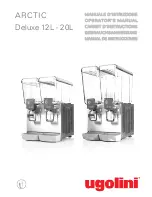
https://www.naturewater.eu
Item 63924
Page 16
01 2024-1
If an operating room is available, it is recommended to use the installation method shown in Figure 4.
Otherwise, only the drain pipe and the overflow pipe can be inserted into the floor drain. As shown in
Figure 5, make sure that the two pipes are fixed to the wall to prevent the pipe from being flushed out of
the floor drain when emptying. This can have detrimental effects and lead to damage.
Install connections
•
The connection and laying of the pipe system is carried out in accordance with the provisions
of the construction standards for water supply and drainage pipes. The inlet and outlet interfaces
of the water softener and the water pipe interfaces are connected by a ¾″ PPR inner pipe or a
corrugated pipe and must be installed on the same axis (see installation plan). The inlet and
outlet points must not be installed in reverse.
•
Connect the water inlet and outlet pipes, the drain pipes, and the overflow pipes in sequence to
ensure that all connections are tight and that there are no leaks. It is recommended to use
flexible pipes to connect the water softener inlets and outlets, the drain, and the overflow (note:
304 stainless steel, alloy forged steel, high-strength engineering plastics, and other materials
are to be used for the connection of pipe fittings and valves; valves and pipe fittings made of
iron are strictly prohibited).
Installing the drain and overflow pipes
•
First loosen the clamp and insert it into the prepared pipe, then insert the pipe into the drain and
overflow connection to the floor, and finally turn the clamp onto the connection of the pipe, drain,
and overflow connection and tighten it firmly. The drain and overflow pipe must be secured with
a clamp. (
Note!
This procedure is intended to ensure that the hose is not pushed away or
pushed out of the sewer if the flat is connected to the sewer or the water pressure of the floor
drain is high).
•
The position of the control valve must be higher than the floor drain and the length of the drain
and overflow pipe must not exceed 2 m. The installation of shut-off devices in the drain pipe is
strictly prohibited. The sealing of the pipe fittings may only be made of PTFE.
Instructions for first use
1.
Initial settings of the operating system
When the softener is switched on for the first time, the system indicates that water is being
added. Press the button
to access the operating system and set the current time, the regen-
eration time, and the raw water hardness.
2.
First water supply for water softeners
Before the first water supply, close the water inlet valve of your building, switch the bypass valve
to the operating position and to the unlocked state, press the button
to start regeneration;
“system is back washing” is shown on the display panel. When the power is switched off, the
water softener remains in backwash mode. Open the water inlet valve slowly to ¼ (opening it
quickly can damage the appliance and lead to resin loss). At the beginning, the sound of slowly
escaping air should be heard in the blow-off pipe. After the air in the FRP tank has escaped
(i.e., when the water in the blow-off pipe flows out evenly), the water inlet valve should be fully
opened.
Attention!
If the water inlet valve is fully opened directly, the water will flow into the softener too quickly,
causing the softener resin in the tank to be stirred up, which will easily cause the upper collection tank
to break and damage the softener. It is therefore necessary to open the water inlet valve slowly ¼ to
allow the water to flow slowly into the tank, release the air in the tank and fill the tank with tap water.
During backwashing, the outlet of the blow-off pipe must be checked several times until it is really clean.
The backwash time should not be less than 5
min.
3.
First filling of the brine tank with water
After completing the above steps, switch on the system. Press to call up the brine and slow
rinse option, then press once to call up the refill option. In the refill option, a certain amount












































